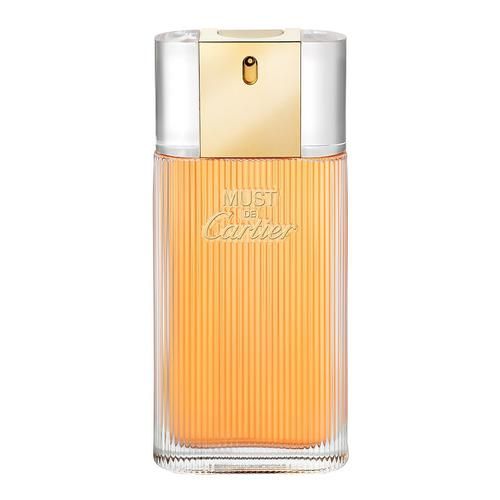Must, heightened sensuality
Very appreciated in the royal courts of Europe, it is said of the Cartier house that it is “the jeweler of Kings or the King of jewelers”. The brand then diversified into other universes, particularly in watchmaking and perfumery. If the Cartier house registered its name in the field of perfumery in 1938, it was not until 1981 to discover its first perfume “Must”.
Must, the enfant terrible of perfumery
In 1973, Cartier invented a lighter which he called “Must”. Great worldwide success, the Must lighter is the first item sold outside Cartier boutiques. It was in 1981 that “Must” was transformed into a perfume, the very first of the brand. By creating “Must”, an oriental juice, Cartier did not hesitate to shake up the codes of perfumery. The galbanum, a very green note, found in the top note brings a taste of anarchy. This is the first time that galbanum has been used in an oriental fragrance. Pineapple also created a surprise, because it is rarely used, and here it replaces bergamot, more classic for the time. With “Must”, Cartier is rejuvenating Orientals and is part of the lineage of famous Orientals, like the very mythical “Shalimar” by Guerlain.
Must, the sensuality of a great oriental
The oriental green “Must” has thus shaken up the codes of perfumery of the 80s. From the first notes, we can see an exacerbated sensuality, a femininity more than present. “Must” takes off on the energizing notes of galbanum. This is associated with other olfactory notes such as pineapple, and vanilla which brings its share of exoticism. The heart, meanwhile, looks like a huge bouquet of flowers between East and West, with rose, narcissus, neroli, jasmine. The base is very sensual, almost animal, thanks to the presence of musk, civet, sandalwood, tonka bean and amber. Sensuality and mystery surround this unique fragrance. As for the bottle, it is inspired by the famous lighter. Oval in structure, the case of Must is embellished with vertical tars and a golden frame. Another innovation, the bottle is refillable so that it can be stored like a precious jewel from the house of Cartier. In 2000, “Must” was adorned with a new, more modern bottle.
Cartier’s first fragrance “Must” is considered the enfant terrible of perfumery. He upset and revolutionized the world of perfumes of the 80s, thanks in particular to the use of galbanum notes in an oriental perfume. Worthy of legendary and timeless perfumes, “Must” has joined the big names in oriental juices like Shalimar de Guerlain.
Released in 1984, ” Must “is the first fragrance from the Cartier house. At the beginning, “Must” was only a lighter, the first item marketed by the brand. “Must” is the representation of heightened sensuality. Sophisticated and mysterious, the “Cartier” woman is therefore associated here with a lighter, which leaves an additional enigma hovering, and which suggests that “Must” is a masculine fragrance. Bold, the composition resembles an oriental juice. Powerful, and sure of herself, this composition is signed Jean-Charles Diener.
Cartier disrupts the codes of perfumery with Must
For his first perfume, the Cartier house chose Jean-Pierre Diener as perfumer. This first fragrance is not only daring, but it really upsets the codes of perfumery. An oriental juice refreshed by the intensity of the galbanum then appears very daring for the time. This eastern accord is above all unique. Indeed, galbanum was not used to being used in oriental compositions, but rather flowery, citrus or woody. Also known as a “grommous ferrule”, galbanum is a perennial plant native to Central Asia. Galbanum is a gum-resin, more or less dry and solid. Since ancient Egypt, galbanum has been used for its mainly antibacterial, antispasmodic and anti-infectious medicinal properties. In perfumery, galbanum is used for its particularly green and earthy scent. Galbanum gum is harvested by incising the roots of the plant. The gum is then distilled to obtain an essence.
Must de Cartier, ultra sensual scented notes
“Must” begins with a most unusual and truly daring association with the presence of peach, galbanum, pineapple and tangerine giving the whole a green and tangy freshness. Native to South America, pineapple is an edible fruit. It was Christopher Columbus who discovered pineapple on his second voyage to the New World. In 1535, the pineapple was unanimous in the Court of Spain. Louis XIV will require his gardeners to grow pineapples in the gardens of Choisy-le-Roi. The plant that produces the fruit is a herbaceous perennial forming a tuft that can reach 1.50 high! Pineapple is rich in vitamins and iron and is a popular summer fruit because it is very thirst-quenching. In perfumery, the pineapple note is reproduced in the laboratory mainly thanks to the “allyl caproate” molecule. Pineapple gives off fruity, sweet and exotic tones. Then, the heart of “Must” is very feminine, because it is essentially floral. It combines jasmine, rose, narcissus and neroli. The Narcissus flower is originally a rather tragic legend since it is linked to the myth of the young man known as the Narcissus. Son of the river god and a nymph, he fell in love with his reflection, due to his immense beauty. The first narcissus flowers sprang up around the basin where he drowned from his own obsession. In perfumery, the narcissus offers both floral and green tones. Finally, the base of “Must” is opulent and sensual, because it combines tonka bean, vanilla, white musks, sandalwood and amber.
Green
